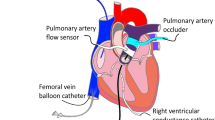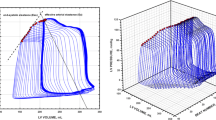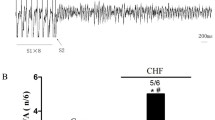Abstract
The time constant of left ventricular pressure fall, τ, has frequently been used as a measure of myocardial relaxation in the blood-perfused, ejecting heart. The aim of the present study was to characterise τ in relation to β-adrenergic activation, coronary perfusion pressure and flow as well as cardiac oxygen supply and demand in the isolated, isovolumically beating heart. Therefore, τ was analysed from digitised left ventricular pressure data in a total of 23 guinea pig hearts perfused with saline at constant pressure (60 cmH2O). The coronary venous adenosine concentration ([ADO]) served as an index of myocardial oxygenation. Isoprenaline (0.4–3.2 nmol l−1) decreased and propranolol (3–9 μmol l−1) increased τ dose-dependently (linear regression τ vs lg ([isoprenaline]),r=0.74; τ vs. lg([propranolol]),r=0.66, bothP<0.05). During graded reductions in cardiac oxygen supply from 96.1±12.6(SEM) to 44.4±4.4 μl min−1 g−1, τ was prolonged from 61.5±12.7 to 109.9±22.6 ms while left ventricular developed pressure (LVDP) decreased from 90.7±7.2 to 40.7±5.1 mmHg. In parallel, [ADO] increased from 23.7±9.1 to 58.0±19.1 pmol ml−1 (P<0.05). Increasing oxygen supply to 165.4±32.4 μl min−1 g−1 augmented LVDP to 102.7±7.3 mmHg but did not change τ or [ADO]. There was a dual response of τ to changes in cardiac oxygen supply or demand. As long as oxygen supply and demand matched, τ remained constant. However, when the oxygen supply was less than 100 μl min−1g−1, left ventricular relaxation was prolonged in parallel to the reduction in oxygen supply. In addition, a close relationship was observed between [ADO] as an indicator of myocardial oxygenation and τ (Spearman correlation,r=0.99,P<0.005). We conclude that the time constant of left ventricular pressure fall, τ, sensitively reflects myocardial relaxation in the isolated, isovolumically beating guinea pig heart. Moreover, in this model left ventricular relaxation is not influenced by alterations in coronary perfusion pressure or flow as long as cardiac oxygen demand is matched by an adequate supply. Rather, relaxation is strictly coupled to myocardial oxygenation as reflected by coronary venous adenosine concentrations.
Similar content being viewed by others
References
Arnold G, Kosche F, Miessner E, Neitzert A, Lochner W (1968) The importance of the perfusion pressure in the coronary arteries for the contractility and the oxygen consumption of the heart. Pflügers Arch 299:339–356
Bardenheuer H, Schrader J (1986) Supply-to-demand ratio for oxygen determines formation of adenosine by the heart. Am J Physiol (Heart Circ Physiol) 250:H173-H180
Blaustein AS, Gaasch WH (1983) Myocardial relaxation. VI. Effects of β-adrenergic tone and asynchrony on LV relaxation rate. Am J Physiol (Heart Circ Physiol) 244:H417-H422
Brutsaert DL, Rademakers FE, Sys SU (1984) Triple control of relaxation: implications in cardiac disease. Circulation 69:190–196
Brutsaert DL, Sys SU (1989) Relaxation and diastole of the heart. Physiol Rev 69:1228–1315
Deussen A, Borst M, Schrader J (1988) Formation of S-adenosylhomocysteine in the heart. I: An index of free intracellular adenosine. Circ Res 63:240–249
Deussen A, Schrader J (1991) Cardiac adenosine production is linked to myocardial pO2. J Mol Cell Cardiol 23:495–504
Downey JM (1976) Myocardial contractile force as a function of coronary blood flow. Am J Physiol 230:1–6
Goethals MA, Housmans PR, Brutsaert DL (1980) Load-dependence of physiologically relaxing cardiac muscle. Eur Heart J 1 (Suppl A):81–87
Gorman MW, He M, Sparks HV (1994) Adenosine formation during hypoxia in isolated hearts: effect of adrenergic blockade. J Mol Cell Cardiol 26:1613–1623
Gregg DE, Rayford CR, Khouri EM, Kattus AA, McKeever WP (1957) Effect of alteration of coronary perfusion pressure on oxygen uptake of left myocardium. Circulation 16:888 [Abstr]
Gwirtz PA, Dodd JM, Brandt MA, Jones CE (1990) Augmentation of coronary flow improves myocardial function in exercise. J Cardiovasc Pharmacol 15:752–758
Henning RJ, Levy MN (1991) Effects of autonomic nerve stimulation, asynchrony, and load on dP/dt max and on dP/dt min. Am J Physiol (Heart Circ Physiol) 260:H1290-H1298
Karliner JS, LeWinter MM, Mahler F, Engler R, O'Rourke RA (1977) Pharmacologic and hemodynamic influences on the rate of isovolumic left ventricular relaxation in the normal conscious dog. J Clin Invest 60:511–521
Lorell BH, Wexler LF, Monomura SI, Weinberg E, Apstein CS (1986) The influence of pressure overload left ventricular hypertrophy on diastolic properties during hypoxia in isovolumically contracting rat hearts. Circ Res 58:653–663
Martin G, Gimeno JV, Cosin J, Guillem MI (1984) Time constant of isovolumic pressure fall: new numerical approaches and significance. Am J Physiol (Heart Circ Physiol) 247:H283-H294
Miller WP, Nellis SH, Liedtke AJ, Whitesell L, Effron BA (1990) Coronary hyperperfusion and ventricular function in intact and isovolumic pig hearts. Am J Physiol (Heart Circ Physiol) 258:H500-H507
Miller WP, Shimamoto N, Nellis SH, Liedtke AJ (1987) Coronary hyperperfusion and myocardial metabolism in isolated and intact hearts. Am J Physiol (Heart Circ Physiol) 253:H1271-H1278
Schulz R, Guth BD, Heusch G (1991) No effect of coronary perfusion on regional myocardial function within the autoregulatory range in pigs. Evidence against the Gregg phenomenon. Circulation 83:1390–1403
Serizawa T, Vogel WM, Apstein CS, Grossman W (1981). Comparison of acute alterations in left ventricular relaxation and diastolic chamber stiffness induced by hypoxia and ischemia. J Clin Invest 68:91–102
Smith VE, Weisfeldt ML, Katz AM (1986) Relaxation and diastolic properties of the heart. 803–817
Smolenski RT, Schrader J, Grott HD, Deussen A (1991) Oxygen partial pressure and free intracellular adenosine of isolated cardiomyocytes. Am J Physiol (Cell Physiol) 260: C708-C714
Sparks HV Jr, Bardenheuer H (1986) Regulation of adenosine formation by the heart. Circ Res 58:193–201
Thompson DS, Waldron CB, Juul SM et al. (1982) Analysis of left ventricular pressure during isovolumic relaxation in coronary artery disease. Circulation 65:690–697
Weisfeldt ML, Weiss JL, Frederiksen JT, Yin FCP (1980) Quantification of incomplete left ventricular relaxation: relationship to the time constant for isovolumic pressure fall. Eur Heart J 1:119–129
Weiss JL, Frederiksen JW, Weisfeldt ML (1976) Hemodynamic determinants of the timecourses of fall in canine left ventricular pressure. J Clin Invest 58:751–760
Author information
Authors and Affiliations
Rights and permissions
About this article
Cite this article
Schäfer, S., Schlack, W., Kelm, M. et al. Characterisation of left ventricular relaxation in the isolated guinea pig heart. Res. Exp. Med. 196, 261–273 (1996). https://doi.org/10.1007/BF02576850
Received:
Accepted:
Issue Date:
DOI: https://doi.org/10.1007/BF02576850




